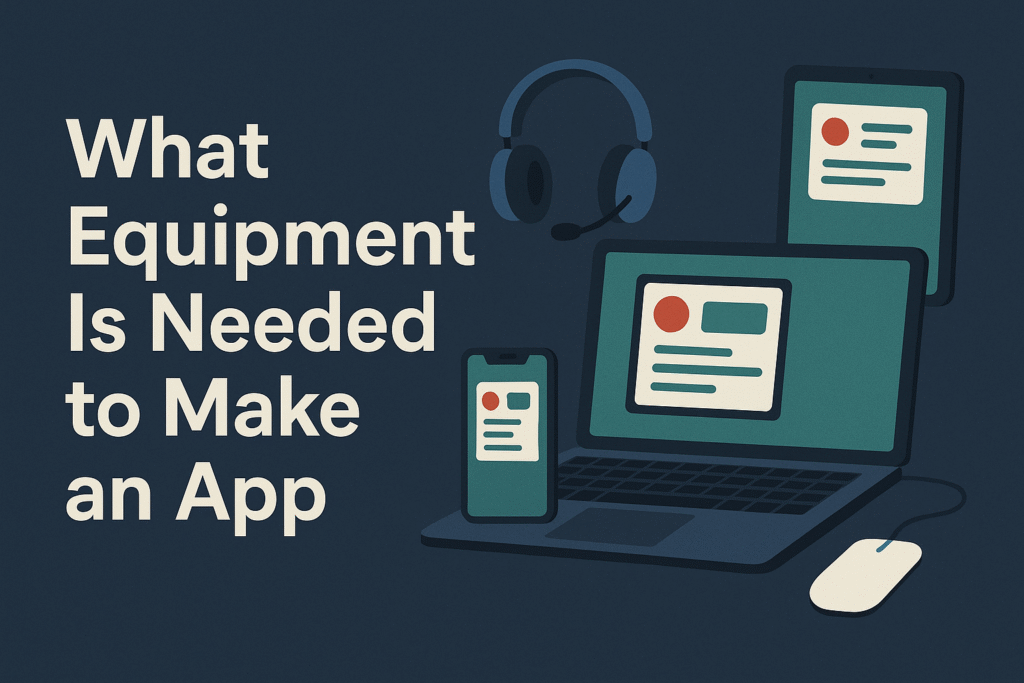What Equipment Is Needed to Make an App
Let me tell you upfront — you don’t need a Silicon Valley setup to start building apps. I’ve helped indie devs launch apps from a bedroom with a second-hand laptop. And I’ve seen teams burn through $100k setups without shipping a single build. The difference isn’t the gear. It’s how well you use it.
So if you’re wondering what equipment is actually needed to make an app, I’ll break it down based on real-world scenarios — whether you’re solo, hiring a developer, or building with a small team.
🧰 Core Equipment You Absolutely Need
Here’s the gear I recommend starting with — even if you’re bootstrapping:
- Laptop or Desktop Computer: This is non-negotiable. You don’t need a MacBook Pro, but you do need something reliable with enough RAM (8GB+), SSD storage, and a decent CPU (Intel i5 or M1 at minimum).
- Smartphones for Testing: If you’re building for iOS and Android, you’ll want at least one real device for each. Emulators help, but nothing beats real-world testing.
- Internet Connection: Sounds obvious, but you need stable internet — especially when pushing builds, pulling from Git, or testing APIs.
- External Monitor (Optional but Helpful): Your IDE, preview device, and documentation open at once? Life-changing.
🛠️ Software Tools You’ll Need (Technically “Equipment” Too)
Let’s be real — “equipment” in app dev includes software just as much as hardware. Here’s what I use on every project:
- Code Editor: Visual Studio Code (free, powerful) or Xcode (for macOS/iOS only)
- SDKs & Emulators: Android Studio and Xcode Simulator help test apps without real devices
- Version Control: GitHub + Git CLI or GitKraken for tracking changes
- Design Tools: Figma or Adobe XD for wireframes, UI/UX
- Project Management: Trello, Notion, or Jira (especially if you’re working with a team)
Bonus tools like Postman (for APIs) and Firebase (for authentication, analytics) often become essential as your app grows.
📦 Should You Get an iMac, MacBook, or Windows PC?
If you’re building iOS apps — you’ll need a Mac. No way around that. Apple restricts Xcode and iOS builds to macOS. But you don’t need the newest M3 MacBook. A used M1 model works perfectly and compiles builds fast.
For Android, any decent Windows PC or Mac works. Android Studio is cross-platform. But your system should have at least:
- Intel i5 / Ryzen 5 processor or better
- 8GB RAM (16GB preferred if you’re multitasking with emulators)
- SSD (not HDD — trust me, build times will crush you)
🎯 Equipment Setup Based on Developer Type
| Developer Type | Recommended Setup |
|---|---|
| Solo iOS Developer | MacBook Air M1, iPhone 12, Xcode, TestFlight |
| Solo Android Developer | Windows Laptop (i5+), Pixel 6A, Android Studio, Genymotion |
| Cross-platform Dev (React Native/Flutter) | MacBook or Windows Laptop (16GB RAM), 1 Android + 1 iOS device |
🧪 Don’t Forget Testing Gear
Testing is where a lot of indie devs cut corners — don’t.
- Use multiple screen sizes (old phones matter — users still have them)
- Buy a budget Android ($100 range) to test low-end performance
- Use Firebase Test Lab to automate device testing at scale
And if you’re targeting tablet users, definitely check my guide on how tablet usage is shaping gaming and media apps.
⚡ Final Word: It’s Not About Gear, It’s About Execution
You don’t need the most expensive setup to build a successful app. You need discipline, focus, and the right stack that fits your goal. Start with the basics, level up your tools as your app scales, and invest in the *right people* before fancy hardware.
If you’re still stuck wondering whether to go native, hybrid, or cross-platform, make sure you start by hiring the right dev or agency — here’s the full guide I wrote to help with that.


